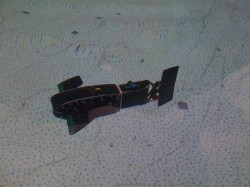I have always been interested in remotely piloted vehicles and the radio-control (RC) hobby, though it was only recently that I started actually participating in it. Ever since my childhood, I had dreamed about placing a wireless video camera inside an RC airplane to experience flight from a first person perspective. As a child, the dream was just that: a dream; fun to think about but mostly unachievable due to the massive learning curve. The cost of the RC hobby was prohibitive at that time, as was the cost (and weight) of the electronics necessary to enable wireless video transmission. Even learning to fly an RC airplane was problematic because there was no room for error once your model left the ground.
Fast forward to the mid 2000s where my interest in unmanned, remotely piloted vehicles led me to engineering school. As a new EE grad I had a strong technical background and the RC hobby was mature and relatively affordable. Lost in a myriad of excuses, I still kept postponing my plans. A few years later, I had the opportunity to earn my private pilot certificate and I jumped on it. Even the experience of real flight didn’t deter my desire to experience first-person RC flight. It wasn’t until last Christmas that the RC bug finally bit. Unwilling to take the step of buying my first model, it was bought for me as a present from my in-laws. I received a Syma S107, IR-controlled, 3-channel helicopter. That was all it took. I was now an RC hobbyist.
The Syma S107 led to my purchase of another one, followed quickly by the purchase of a DX6i transmitter and three Blade Helicopters: a MCX2, MSRX, and 120SR. A month after that I picked up Eflite’s version of the Sbach 342. As of today, I have several kits I have yet to put together: an Align 500 EFL and a Multiplex EZ Glider. While my other RC models are too small to hold serious video equipment, the latter two are prefect for it. Unfortunately, I wasn’t willing to jump into FPV (first-person-view) with two aircraft simply because a single mistake would lead to a crash and loss of some serious hardware. So, I bought a Traxxas Summit for ground FPV. This will let me experiment, build up my ground station and make mistakes that, at worse, would lead to me walking a few hundred feet to overturn a flipped truck.
I picked the Summit because of its utility. The truck has a remotely-operable, two-speed transmission for low and high gear. The low gear mode can be further augmented by locking front and rear differentials. The truck also features four-wheel independent suspension. I wanted something that allows me to really explore and get out of tricky spots if necessary. In the weeks/months to come, I will convert this very capable off-road RC truck into an FPV machine and report on my progress in future blog posts. This is a sample of what I hope to do in the near future:
